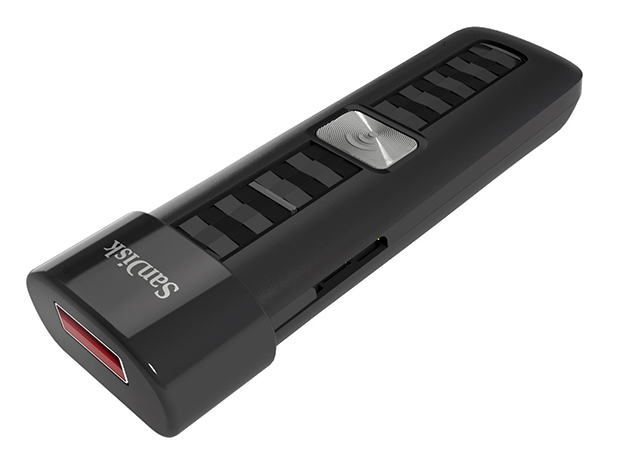SanDisk Connect Wireless Flash Drive, first take: Useful, but pricey


USB memory sticks are convenient for transferring and carrying files — unless, of course, you're using a phone or a tablet that lacks a USB port. You can always keep your files in the cloud, but if you want to back up 10GB of high-resolution photos from a Lumia 1020, or get three HD movies onto your iPad to watch on a long plane journey, then uploading and downloading those files takes quite a while (and when you're travelling, data and wi-fi costs can add up).
SanDisk's solution is to add wireless (2.4GHz 802.11b/g/n wi-fi) to the memory stick. You can still copy files on anything with a USB port, but you can also use it with any device that has wi-fi. We've seen this with portable hard drives in the past, but the SanDisk Connect Wireless Flash Drive, while bulky for a memory stick, is quite a bit smaller. It's also expandable because the 64GB of storage it comes with is actually a MicroSD card that you can remove and replace with something bigger. Or you could carry a couple of cards with you and swap between them — the card slot is on the side, protected by a cover that fits safely but is easy to pop off.
Getting connected to the drive is a little more complex. You can plug it into a PC or Mac to load it up with files straight away and it will charge the battery that the wireless uses while it's in the USB port. But in practice you'll want to charge it for a while before transferring files because if it's very flat you'll find it powers down and then up again as you're using it, causing the drive to disappear and reappear in Explorer. And that power level won't be enough for wi-fi.
As a USB 2.0 memory stick, file transfer speeds are what you'd expect: copying files to the SanDisk Connect from the USB 3.0 port on a Surface 2 tablet peaked at 12Mbps; copying files back to the Surface 2 peaked at 14Mbps.
SanDisk offers iOS, Kindle and Android apps for the Connect; other devices can connect to it through the browser, at a fixed URL — but only once you've connected to the USB stick as your wi-fi access point. In the Windows Phone browser, say, you see folder and files, but no thumbnails; the app shows thumbnails, which makes it easier to pick the photo you want from an album. A browser connection lets you change some basic settings, like renaming the Connect SSID, putting it on a different Wi-Fi channel, changing the 30-minute timeout for saving power and turning on WPA2 security so you need a password to get to the drive. However, you need the app to flash the drive with new firmware, bulk-download files (rather than opening and saving them), copy files to the Connect (including making new folders), see the battery level or set up pass-through Wi-Fi. As a result, we couldn't use the Connect to back up a Lumia phone directly, but it proved a handy way to copy screenshots and photos from an iPhone right onto a memory stick that we could plug into any PC.
With the iOS app, you can associate the Connect to a wi-fi access point so that when your phone or tablet connects to the USB stick it also gets an internet connection. Even with the Internet Connection setting turned on, other devices that connect to the drive without an app can't piggyback on the internet connection — they still only see the Connect itself. Putting the drive into Internet Connection mode also disables the password protection, so anyone else who has the SanDisk app installed, or who just knows the www.sandisk.com/WFD URL can connect to your drive and access files. They'd have to be on the same wi-fi network as you, but it's worth bearing in mind if you keep private files on the drive.
The battery in the Connect delivers between four and six hours of streaming movies — less if you connect from multiple devices at once, longer if you're copying a few files and coming back to it later. However, you can't just toss it in your bag and expect it to be charged a month later, so you do need to plan ahead a little. We also found that after using it wirelessly, the Connect would occasionally fail to work as a standard USB device.
Android, iOS and Kindle users will get the most out of the Connect, although $99.99 is on the pricey side for a 64GB memory stick (it can be found online in the UK for around £80). But if you want to carry lots of media with you, it's a convenient way to do it.